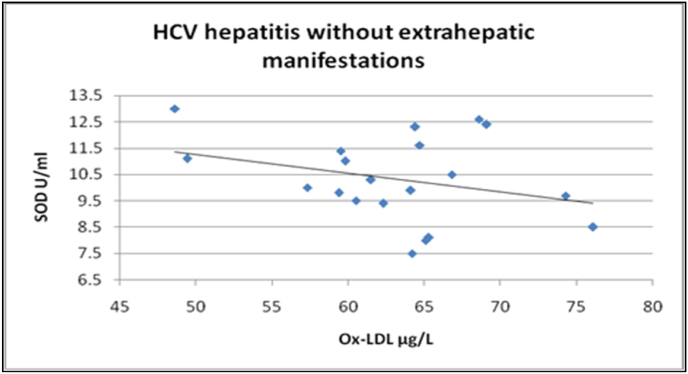氧化低密度脂蛋白与慢性非肝硬化HCV患者的肝外表现有关吗?
IF 2.7
引用次数: 0
摘要
背景:病毒性肝炎引起的组织损伤是世界范围内发病率和死亡率的主要原因。氧化反应和活性氧(ROS)将血浆低密度脂蛋白(LDL)中的蛋白质和脂质转化为异常氧化的低密度脂蛋白(ox-LDL)。丙型肝炎病毒(HCV)感染可从多个来源诱导氧化/亚硝化应激,包括诱导型一氧化氮合酶(iNOS)、线粒体电子传递链、肝细胞NAD(P)H氧化酶(NOX酶)和炎症。此外,HCV降低还原性谷胱甘肽(GSH)的合成和再生。设计:横截面。目的:量化慢性非肝硬化HCV患者血清ox-LDL含量,并评估ox-LDL与HCV诱导的肝外表现的相关性。患者和方法:20例有肝外表现的慢性非肝硬化女性HCV患者,20例无肝外表现的慢性非肝硬化女性HCV患者和20例年龄、性别匹配的健康对照组。方法:用血清测定肝功能、ox-LDL和细胞外抗氧化酶超氧化物歧化酶EC CuZn-SOD。结果:有肝外表现的患者ox-LDL含量(76.63±6.86 μg/L)高于无肝外表现的患者(63.05±6.6 μg/L) p。结论:肝外表现与HCV感染的人体测量变化无关。肝外表现与高血清ox-LDL相关。在慢性HCV患者中,高水平的ox-LDL与-或由于血清EC CuZn-SOD表达失调。本文章由计算机程序翻译,如有差异,请以英文原文为准。


Do oxidized low-density lipoproteins link to extra hepatic manifestations in chronic, non-cirrhotic HCV patients?
Background
Tissue damage by viral hepatitis is a major cause of morbidity and mortality worldwide. Oxidation reactions and reactive oxygen species (ROS) transform proteins and lipids in plasma low-density lipoproteins (LDL) into the abnormal oxidized LDL (ox-LDL). Hepatitis C virus (HCV) infection induces oxidative/nitrosative stress from multiple sources, including the inducible nitric oxide synthase (iNOS), the mitochondrial electron transport chain, hepatocyte NAD(P)H oxidases (NOX enzymes), and inflammation. Further, HCV decreases reduced glutathione (GSH) synthesis and regeneration.
Design
Cross-section.
Objective
to quantify ox-LDL in serum of chronic non-cirrhotic HCV patients, and to assess ox-LDL association with HCV-induced extra hepatic manifestations.
Patients and methods
Twenty chronic, non-cirrhotic HCV female patients with extra hepatic manifestations, twenty chronic, non-cirrhotic female HCV patients without extra hepatic manifestations and twenty healthy age, sex matched controls.
Methods
Serum was used for determination of liver function tests, ox-LDL and the extracellular antioxidant enzyme Superoxide Dismutase EC CuZn-SOD.
Results
Patients with extra hepatic manifestations had statistically higher ox-LDL (76.63 ± 6.86 μg/L) than patients without extra hepatic manifestations (63.05 ± 6.6 μg/L) p < 0.001, and both patient groups had higher ox-LDL levels than the control group (44.1 ± 4.1 μg/L) p < 0.001. EC CuZn-SOD correlated negatively with ox-LDL in HCV patients with extra hepatic manifestation only.
Conclusion
Extra hepatic manifestations were not risk for anthropometric changes seen with HCV infection. Extra hepatic manifestations were associated with high serum ox-LDL. High serum levels of ox-LDL associated with- or were due to deregulated expression of serum EC CuZn-SOD in chronic HCV patients.
求助全文
通过发布文献求助,成功后即可免费获取论文全文。
去求助
来源期刊

Metabolism open
Agricultural and Biological Sciences (General), Endocrinology, Endocrinology, Diabetes and Metabolism
自引率
0.00%
发文量
0
审稿时长
40 days
 求助内容:
求助内容: 应助结果提醒方式:
应助结果提醒方式:


